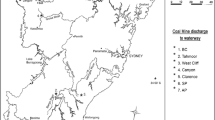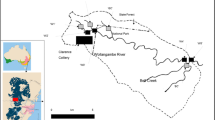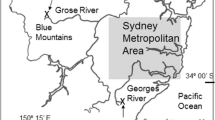Abstract
This study examined a single underground coal mine and investigated two aspects of its operation: the disposal of the mine waste through a discharge to a nearby river and the impact of subsidence from an underground longwall to a small waterway above. Water quality of the two waterways was monitored over a 2-year period with a monthly investigation over a 6-month period, which included collection of stream macroinvertebrates. Both mine activities modified surface water geochemistry and macroinvertebrate communities. Mean electrical conductivity (EC) increased in surface waters below the mine discharge, rising 4.8 times from (186 μS/cm) upstream to 1078 μS/cm below the waste inflow. Mean EC increased in a small stream that was disturbed by subsidence from longwall mining, rising 3.8 times from (247 μS/cm) upstream to 1195 μS/cm below. The mineral constituents of the increased salinities were different. The coal mine wastewater discharge was enriched with sodium and bicarbonate ions compared to sodium and chloride ions in the subsidence affected creek. Both the waste discharge and the subsidence caused increases in the concentrations of zinc by about four times and nickel by 20 to 30 times the background levels. The subsidence reduced dissolved oxygen to ecologically stressful levels and increased iron and manganese concentrations by about 20 times the background levels. Two of the key changes in stream ecosystems were a reduction in the proportion of mayfly larvae downstream of the mine waste discharge and mosquito larvae dominating (60–70 % of total abundance) the invertebrate community in the subsidence affected creek.



Similar content being viewed by others
References
ANZECC (Australian and New Zealand Environment and Conservation Council) and ARMCANZ (Agriculture and Resource Management Council of Australia and New Zealand). (2000). Australian and New Zealand guidelines for fresh and marine waters (National Water Quality Management Strategy Paper No. 4). Canberra: Australian and New Zealand Environment and Conservation Council/ Agriculture and Resource Management Council of Australia and New Zealand.
APHA (American Public Health Association). (1998). Standard Methods for the Examinatio.n of Water and Wastewater (20th ed.). Washington, DC: American Public Health Association.
Banks, D., Younger, P. L., Arnesen, R.-T., Iversen, E. R., & Banks, S. B. (1997). Mine-water chemistry: the good, the bad and the ugly. Environmental Geology, 32, 157–174.
Battaglia, M., Hose, G. C., Turak, E., & Warden, B. (2005). Depauperate macroinvertebrates in a mine affected stream: clean water may be the key to recovery. Environmental Pollution, 138, 132–141.
Belmer, N., Tippler, C., Davies, P. J., & Wright, I. A. (2014). Impact of a coal mine waste discharge on water quality and aquatic ecosystems in the Blue Mountains World Heritage Area. In G. Viets, I. D. Rutherfurd & R. Hughes (Eds.), Proceedings of the 7 th Australian Stream Management Conference, Townsville, Queensland (pp. 385–391). River Basin Management Society. https://asnevents.s3.amazonaws.com/Abstrakt-FullPaper/11658-7ASM-67%20Belmer.pdf. Accessed 8 May 2015
Booth, C. J., & Bertsch, L. P. (1999). Groundwater geochemistry in shallow aquifers above longwall mines in Illinois, USA. Hydrogeology Journal, 7, 561–575.
Brake, S. S., Connors, K. A., & Romberger, S. B. (2001). A river runs through it: impact of acid mine drainage on the geochemistry of West Little Sugar Creek pre- and post-reclamation at the Green Valley coal mine, Indiana, USA. Environmental Geology, 40, 1471–1481.
Chessman, B. C. (1995). Rapid assessment of rivers using macroinvertebrates: a procedure based on habitat-specific sampling, family level identification and a biotic index. Australian Journal of Ecology, 20, 122–129.
Clarke, K. R. (1993). Non-parametric multivariate analyses of changes in community structure. Australian Journal of Ecology, 18, 117–143.
Clements, W. H., Carlisle, D. M., Lazorchak, J. M., & Johnson, P.C. (2000). Heavy metals structure benthic communities in Colorado mountain streams. Ecological Applications, 10, 626–638.
García-Criado, F., Tomé, A., Vega, F. J., & Antolín, C. (1999). Performance of some diversity and biotic indices in rivers affected by coal mining in northwestern Spain. Hydrobiologia, 394, 209–217.
Gray, N. F. & Delaney, E. (2008). Comparison of benthic macroinvertebrate indices for the assessment of the impact of acid mine drainage on an Irish river below an abandoned C- S mine. Environmental Pollution, 155, 31–40.
Greenfield, J. P., & Ireland, M. P. (1978). A survey of the macrofauna of a coal-waste polluted Lancashire fluvial system. Environmental Pollution, 16, 105–122.
Hart, B. T., & McKelvie, I. D. (1986). Chemical Limnology in Australia. In W. D. Williams & P. De Deckker (Eds.), Limnology in Australia (pp. 3–31). CSIRO Publishing: Collingwood, Melbourne.
Hellawell, J. M. (1986). Biological Indicators of Freshwater Pollution and Environmental Management. London: Elesvier.
Hynes, H. B. N. (1960). The Biology of Polluted Waters. Liverpool: Liverpool University Press.
Jankowski, J. (2007). Changes of water quality in a stream impacted by longwall mining subsidence In: Mine Subsidence 2007. Proceedings of the Seventh Triennial Conference on Mine Subsidence, Sydney, N.S.W. Mine Subsidence Technological Society, 2007. (pp. 241–251).
Jarvis, A. P., & Younger, P. L. (1997). Dominating chemical factors in mine water induced impoverishment of the invertebrate fauna of two streams in the Durham Coalfield, UK. Chemistry and Ecology, 13, 249–270.
Johnson, D. B. (2003). Chemical and microbiological characteristics of mineral spoils and drainage waters at abandoned coal and metal mines. Water, Air, and Soil Pollution, 3, 47–66.
Kiffney, P. M., & Clements, W. H. (1994). Structural responses of benthic macroinvertebrate communities from different stream orders to zinc. Environmental Toxiciology and Chemistry, 13, 389–395.
Krogh, M. (2007). Management of longwall coal mining impacts in Sydney’s southern drinking water catchments. Australian Journal of Environmental Management, 14, 155–165.
Lenat, D. R., & Penrose, D. L. (1996). History of the EPT taxa richness metric. Bulletin of the North American Benthological Society, 13, 305–307.
Mireji, P. O., Keating, J., Hassanali, A., Mbogo, C. M., Nyambaka, H., Kahindi, S., & Beier, J. C. (2008). Heavy metals in mosquito larval habitats in urban Kisumu and Malindi, Kenya, and their impact. Ecotoxicology and Environmental Safety, 70, 147–153.
Moon, T. C., & Lucostic, C. M. (1979). Effects of acid mine drainage on a southwestern Pennsylvania stream. Water, Air and Soil Pollution., 11, 377–390.
NSW Protection of the Environment Operations Act (1997). Available at: (http://www.austlii.edu.au/au/legis/nsw/consol_act/poteoa1997455/).
Petty, J. T., Fulton, J. B., Strager, M. P., Merovich, G. T., Stiles, J. M., & Ziemkiewicz, P. F. (2010). Landscape indicators and thresholds of stream ecological impairment in an intensively mined Appalachian watershed. Journal of the North American Benthological Society, 29, 1292–1309.
Pigati, E., & López, D. L. (1999). Effect of subsidence on recharge at abandoned coal mines generating acidic drainage: the Majestic Mine, Athens County, Ohio. Mine Water and the Environment, 18, 45–66.
Pond, G. J. (2010). Patterns of Ephemeroptera taxa loss in Appalachian headwater streams (Kentucky, USA). Hydrobiologia, 641, 185–201.
Pond, G. J., Passmore, M. E., Borsuk, F. A., Reynolds, L., & Rose, C. J. (2008). Downstream effects of mountaintop coal mining: comparing biological conditions using family- and genus-level macroinvertebrate bioassessment tools. Journal of the North American Benthological Society, 27, 717–737.
Resh, V. H., & Jackson, J. K. (1993). Rapid assessment approaches to biomonitoring using benthic macroinvertebrates. In D. M. Rosenberg & V. H. Resh (Eds.), Freshwater Biomonitoring and Benthic Macroinvertebrates (pp. 195–223). New York, London: Chapman & Hall.
Rosenberg, D. M., & Resh, V. H. (1993). Freshwater biomonitoring and benthic macroinvertebrates. New York, London: Chapman & Hall.
Russell, B. M., Muir, L. E., Weinstein, P., & Kay, B. H. (1996). Surveillance of the mosquito Aedes aegypti and its biocontrol with the copepod Mesocyclops aspericornis in Australian wells and gold mines. Medical and Vetinary Entomology, 10, 155–160.
Tahmoor Coal (2014). Tahmoor Underground Management System & Framework Document. Glencore. Tahmoor Coal, PO Box 100, Tahmoor, NSW.
Tippler, C., Wright, I. A., Davies, P. J., & Hanlon, A. (2014). The influence of concrete on the geochemical qualities of urban streams. Marine and Freshwater Research, 65, 1009–1017.
Tippler, C., Wright, I. A., & Hanlon, A. (2012). Is catchment imperviousness a keystone factor degrading urban waterways? A case study from a partly urbanised catchment (Georges River, south-eastern Australia). Water, Air and Soil Pollution, 223, 5331–5344.
Tiwary, R. K. (2000). Environmental impact of coal mining on water regime and its management. Water, Air and Soil Pollution., 132, 185–199.
Verb, R. G., & Vis, M. L. (2000). Comparison of benthic diatom assemblages from streams draining abandoned and reclaimed coal mines and nonimpacted sites. Journal of the North American Benthological Society, 19, 274–288.
Warwick, R. M. (1993). Environmental impact studies on marine communities: pragmatical considerations. Australian Journal of Ecology, 18, 63–80.
Winterbourn, M. J. (1998). Insect faunas of acidic coal mine drainages in Westland, New Zealand. New Zealand Entomologist., 21, 65–72.
Wright, I. A. (2012). Coal mine ‘dewatering’ of saline wastewater into NSW streams and rivers: a growing headache for water pollution regulators. In J. R. Grove & I. D. Rutherfurd (Eds.), Proceedings of the 6 th Australian Stream Management Conference, Managing for Extremes, 6-8 February, 2012 Canberra, Australia (pp 206–213). River Basin Management Society. Available at www.epa.nsw.gov.au/resources/endeavourcoal/DrIWrightAppendix2.pdf. Accessed 8 May 2015
Wright, I. A., & Burgin, S. (2009a). Comparison of sewage and coal-mine wastes on stream macroinvertebrates within an otherwise clean upland catchment, south-eastern Australia. Water, Air and Soil Pollution, 204, 227–241.
Wright, I. A., & Burgin, S. (2009b). Effects of organic and heavy-metal pollution on chironomids within a pristine upland catchment. Hydrobiologia, 635, 15–25.
Wright, I. A., Chessman, B. C., Fairweather, P. G., & Benson, L. J. (1995). Measuring the impact of sewage effluent on the macroinvertebrate community of an upland stream: The effect of different levels of taxonomic resolution and quantification. Australian Journal of Ecology, 20, 142–149.
Younger, P. L. (2004). Environmental impacts of coal mining and associated wastes: a geochemical perspective (pp. 169–209). Geological Society, London: Special Publication 236.
Author information
Authors and Affiliations
Corresponding author
Rights and permissions
About this article
Cite this article
Wright, I.A., McCarthy, B., Belmer, N. et al. Subsidence from an Underground Coal Mine and Mine Wastewater Discharge Causing Water Pollution and Degradation of Aquatic Ecosystems. Water Air Soil Pollut 226, 348 (2015). https://doi.org/10.1007/s11270-015-2598-9
Received:
Accepted:
Published:
DOI: https://doi.org/10.1007/s11270-015-2598-9




